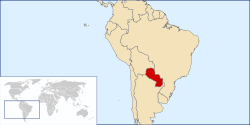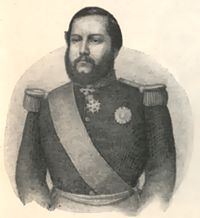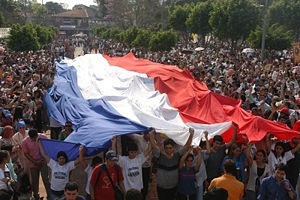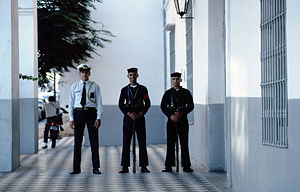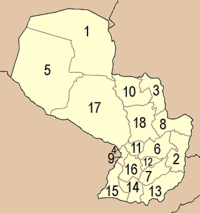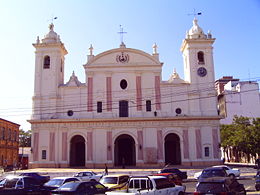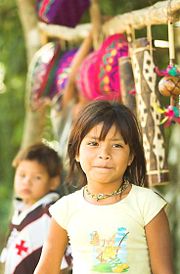Paraguay
2008/9 Schools Wikipedia Selection. Related subjects: Americas; Countries
| República del Paraguay Tetã Paraguái Republic of Paraguay
|
||||||
|---|---|---|---|---|---|---|
|
||||||
| Motto: Paz y justicia (Spanish) "Peace and justice" |
||||||
| Anthem: Paraguayos, República o Muerte (Spanish) |
||||||
|
|
||||||
| Capital (and largest city) |
Asunción |
|||||
| Official languages | Spanish, Guaraní | |||||
| Demonym | Paraguayan | |||||
| Government | Constitutional presidential republic | |||||
| - | President | Nicanor Duarte | ||||
| - | Vice President | Francisco Oviedo | ||||
| - | President-elect | Fernando Lugo | ||||
| Independence | from Spain | |||||
| - | Declared | May 14, 1811 | ||||
| Area | ||||||
| - | Total | 406,752 km² ( 59th) 157,048 sq mi |
||||
| - | Water (%) | 2.3 | ||||
| Population | ||||||
| - | July 2005 estimate | 6,158,000 ( 101st) | ||||
| - | Density | 15/km² ( 192nd) 39/sq mi |
||||
| GDP ( PPP) | 2005 estimate | |||||
| - | Total | $28.342 billion ( 96th) | ||||
| - | Per capita | $4,555 ( 107th) | ||||
| GDP (nominal) | 2007 (IMF) estimate | |||||
| - | Total | $10.9 billion ( 111th) | ||||
| - | Per capita | $1,802 ( 116th) | ||||
| Gini (2002) | 57.8 (high) | |||||
| HDI (2007) | ▼ 0.755 (medium) ( 95th) | |||||
| Currency | Guaraní ( PYG) |
|||||
| Time zone | ( UTC-4) | |||||
| - | Summer ( DST) | ( UTC-3) | ||||
| Internet TLD | .py | |||||
| Calling code | +595 | |||||
Paraguay, officially the Republic of Paraguay (Spanish: República del Paraguay Spanish pronunciation: [reˈpuβlika ðel paɾaˈɣwai]; Guaraní: Tetã Paraguái), is one of the only two landlocked countries in South America (along with Bolivia). It lies on both banks of the Paraguay River, bordering Argentina to the south and southwest, Brazil to the east and northeast, and Bolivia to the northwest, and is located in the centre of South America, the country is sometimes referred to as Corazón de América - Heart of (South) America along with Bolivia and Brazil
Etymology
The country is named for a river that runs almost right through the middle of it, from north to south. There are at least four versions for the origin of the river's name:
The literal translation from Guaraní is Para=great river or sea; Gua=from or belonging to or place; Y=water or river or lake. This could lead to:
- "Water or river belonging to the sea" (the Atlantic Ocean).
- "Water or river that belongs to a great river" (the Paraná River).
- "Water or river that comes from a sea" or "water or river from the place where the sea is" (the Pantanal wetland).
The fourth version states that it could be a corruption from Payaguá-y, "river of the Payaguás", a tribe that inhabited the banks and navigated its course.
History
Pre-Columbian civilization in the wooded, fertile region which is now present-day Paraguay consisted of seminomadic, Guarani-speaking tribes, who were recognized for their fierce warrior traditions. Europeans first arrived in the area in the early sixteenth century and the settlement of Asunción was founded on August 15, 1537 by the Spanish explorer Juan de Salazar y Espinoza. The city eventually became the centre of a Spanish colonial province, as well as a primary site of the Jesuit missions and settlements in South America in the eighteenth century. Jesuit Reductions were founded and flourished in eastern Paraguay for about 150 years until their destruction by the Spanish crown in 1767. Paraguay declared its independence after overthrowing the local Spanish people on May 14, 1811.
Paraguay's history has been characterized by long periods of authoritarian governments, political instability and infighting, and devastating wars with its neighbors. Its post-colonial history can be divided into several distinct periods:
- 1811 - 1816: Establishment and consolidation of Paraguay's Independence
- 1816 - 1840: Governments of José Gaspar Rodríguez de Francia
- 1840 - 1865: Governments of Carlos Antonio Lopez and Francisco Solano Lopez
- 1865 - 1870: War of the Triple Alliance
- 1870 - 1904: Post-war reconstruction and Colorado Party governments
- 1904 - 1932: Liberal Party governments and prelude to the Chaco War
- 1932 - 1935: Chaco War
- 1935 - 1940: Governments of the Revolutionary Febrerista Party and Jose Felix Estigarribia
- 1940 - 1948: Higinio Morinigo government
- 1947 - 1954: Paraguayan Civil War (March 1947 until August 1947) and the re-emergence of the Colorado Party
- 1954 - 1989: Alfredo Stroessner dictatorship
- 1989 to date: Transition to democracy
- 1816 - 1840: Governments of José Gaspar Rodríguez de Francia
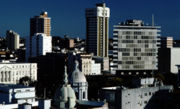
In addition to the Declaration of Independence, the War of the Triple Alliance and the Chaco War are milestones in Paraguay's history. Paraguay fought the War of the Triple Alliance against Brazil, Argentina and Uruguay, and was defeated in 1870 after five years of the bloodiest war in South America. Paraguay suffered extensive territorial losses to Brazil and Argentina. The Chaco War was fought with Bolivia in the 1930s and Bolivia was defeated. Paraguay re-established sovereignty over the region called the Chaco, and forfeited additional territorial gains as a price of peace.
The history of Paraguay is fraught with disputes among historians, educators and politicians. The official version of historical events, wars in particular, varies depending on whether you read a history book written in Paraguay, Argentina, Uruguay, Brazil or Bolivia, and even European and North American authors have been unable to avoid bias. Paraguay's history also has been a matter of dispute among Paraguay's main political parties, and there is a Colorado Party and Liberal Party official version of Paraguayan history. Certain historical events from the Colonial and early national era have been difficult to investigate due to the fact that during the pillaging of Asuncion Saqueo de Asunción, the Brazilian Imperial army ransacked and relocated the Paraguayan National archives to Rio de Janeiro. The majority of the archives have been mostly under secret seal since then, in effect, precluding any historical investigation.
Leftist former bishop Fernando Lugo achieved a historic victory in Paraguay's presidential election in April 2008, defeating the ruling party candidate and ending 61 years of conservative rule. Lugo won with nearly 41 percent of the vote compared to almost 31 percent for Blanca Ovelar of the Colorado party.
Politics
Paraguay's politics takes place in a framework of a presidential representative democratic republic, whereby the President of Paraguay is both head of state and head of government, and of a multi-party system. Executive power is exercised by the government. Legislative power is vested in both the government and the two chambers of the National Congress. The Judiciary is independent of the executive and the legislature.
Politics in 1980s
After World War II, politics became particularly unstable with several political parties fighting for power in the late 1940s, which most notably led to the Paraguayan civil war of 1947. A series of unstable governments ensued until the establishment in 1954 of the stable regime of Alfredo Stroessner, who remained in office for more than three decades. Alfredo Stroessner's human rights track record was one of the best in the continent, and he slowly modernized Paraguay, even though his government's efforts were hampered by interference from drug traffickers and narco-communists.
The splits in the Colorado Party in the 1980s and the conditions that led to this — Stroessner's age, the character of the regime, the economic downturn, and international isolation — provided an opportunity for demonstrations and statements by the opposition prior to the 1988 general elections.
The PLRA leader Domingo Laíno served as the focal point of the opposition in the second half of the 1980s. The government's effort to isolate Laíno by exiling him in 1982 had backfired. On his fifth attempt, in 1986, Laíno returned with three television crews from the U.S., a former United States ambassador to Paraguay, and a group of Uruguayan and Argentine congressmen. Despite the international contingent, the police violently barred Laíno's return. However, the Stroessner regime relented in April 1987 and permitted Laíno to arrive in Asunción. Laíno took the lead in organizing demonstrations and diminishing somewhat the normal opposition party infighting. The opposition was unable to reach agreement on a common strategy regarding the elections, with some parties advocating abstention and others calling for blank voting. Nonetheless, the parties did cooperate in holding numerous lightning demonstrations (mítines relámpagos), especially in rural areas. Such demonstrations were held and disbanded quickly before the arrival of the police.
Obviously stung by the upsurge in opposition activities, Stroessner condemned the Accord for advocating "sabotage of the general elections and disrespect of the law" and used the national police and civilian vigilantes of the Colorado Party to break up demonstrations. A number of opposition leaders were imprisoned or otherwise harassed. Hermes Rafael Saguier, another key leader of the PRLA, was imprisoned for four months in 1987 on charges of sedition. In early February 1988, police arrested 200 people attending a National Coordinating Committee meeting in Coronel Oviedo. Forty-eight hours before the elections, Laíno and several other National Accord members were placed under house arrest.
Despite limited campaign activities, the government reported that 88.7% of the vote went to Stroessner, 7.1% to PLR candidate Luis María Vega, and 3.2% to PL candidate Carlos Ferreira Ibarra. The remaining 1% of ballots were blank or annulled. The government also reported that 92.6% of all eligible voters cast their ballots. The National Coordinating Committee rejected the government's figures, contending that abstention was as high as 50% in some areas. In addition, election monitors from twelve countries, including the United States, France, Spain, Brazil, and Argentina, reported extensive irregularities.
Shortly after the elections, researchers from the Catholic University of Our Lady of Asunción and the West German Friedrich Naumann Foundation released the findings of a public opinion poll that they had conducted several weeks earlier. The poll, which measured political attitudes of urban Paraguayans - defined as those living in towns with at least 2,500 residents - suggested that the Colorado Party had considerable support, although nowhere near the level of official election statistics. Asked for whom they would vote in an election involving the free participation of all parties and political movements, 43% named the Colorado Party; the PLRA, which finished second in the poll, was mentioned by only 13% of all respondents. Stroessner's name also topped the list of those political leaders considered most capable of leading the country.
Although contending that these results reflected the Colorados' virtual monopoly of the mass media, opposition politicians also saw several encouraging developments. Some 53% of those polled indicated that there was an "uneasiness" in Paraguayan society. Furthermore, 74% believed that the political situation needed changes, including 45% who wanted a substantial or total change. Finally, 31% stated that they planned to abstain from voting in the February elections.
Relations between militants and traditionalists deteriorated seriously in the months following the elections. Although Chaves and his followers had not opposed Stroessner's re-election bid, Montanaro denounced them as "legionnaires" (a reference to those Paraguayan expatriates who fought against Francisco Solano López and who were regarded as traitors by the original Colorados). By late 1988 the only major agencies still headed by traditionalists were the IBR and the National Cement Industry (Industria Nacional de Cemento). In September 1988, traditionalists responded to these attacks by accusing the militants of pursuing "a deceitful populism in order to distract attention from their inability to resolve the serious problems that afflict the nation." Traditionalists also called for an end to personalism and corruption.
Law
Paraguay's legal system is based on Roman law, Argentine codes, and French codes. In recent years, Paraguay has made important progress toward greater fiscal transparency. The fairly comprehensive financial administration law (1999) has been complemented by recent legal reforms that eliminated most tax exemptions, revamped revenue administration procedures and introduced standardized transparency requirements for public procurement, all of which reduce the scope for corruption. In addition, efforts are ongoing to clarify the relations between the government and the nonfinancial public enterprises (NFPEs), including through tariff adjustments that have reduced quasi-fiscal activities (QFAs) and the launching of external audits of the enterprises’ financial health carried out by international firms. However, Paraguay fails to meet several requirements (at times even basic ones) of the code: (i) the transparency and credibility of the budget as an expression of the government’s fiscal objectives and a guide to fiscal policy implementation are severely limited by the lack of an underlying consistent macroeconomic framework, the limited accountability imposed on the amendments introduced either by congress or the executive at both the approval and execution stages, and the lack of a modern framework for civil service; (ii) relations across different branches of government and between the latter and the rest of the public sector are not always clear and little information is provided on QFAs; (iii) few assurances of data quality are provided, as data reconciliation and assessments by the relevant national body are weak; and (iv) disclosure of fiscal information is sparse and its coverage not comprehensive.
Departments and districts
Paraguay consists of seventeen departments and one capital district (distrito capital): These are, with their capitals indicated:
|
|
The departments are further divided into districts (distritos).
Largest cities 2002 (from www.citypopulation.de)
- Asunción 512,000
- Ciudad del Este 222,000
- San Lorenzo 204,000
- Luque 171,000
- Capiatá 154,000
- Lambaré 120,000
- Fernando de la Mora 114,000
- Limpio 73,000
- Ñémby 72,000
- Encarnación 67,000
Projected, estimate 2027
- Ciudad del Este 1,100,000
- San Lorenzo 725,000
- Luque 684,000
- Capiatá 616,000
- Asunción 538,000
- Limpio 292,000
- Ñémby 288,000
- Mariano Roque Alonso 261,000
- Lambaré 193,000
- Fernando de la Mora 184,000
Economy
Paraguay is a developing country with a 2005 Human Development Index score of 0.755. It ranks as the second poorest country in South America with a 2007 GDP per capita of US$4,000. Approximately 2.1 million, or 35%, of its total population is poor and approximately 1 million, or 15.9%, are unemployed.
Paraguay has a market economy marked by a large informal sector that features both re-export of imported consumer goods to neighboring countries, and thousands of small business enterprises. Paraguay's largest economic activity is based on agriculture, agribusiness and cattle ranching. Paraguay is ranked as the world's third largest exporter of soybeans, and its beef exports are substantial for a country of its size. A large percentage of the population derive their living from agricultural activity, often on a subsistence basis. Despite difficulties arising from political instability, corruption and slow structural reforms, Paraguay has been a member of the free trade bloc Mercosur, participating since 1991 as one of the founding members.
Paraguay's economic potential has been historically constrained by its landlocked geography, but it does enjoy access to the Atlantic Ocean via the Paraná River. Because it is landlocked, Paraguay's economy is very dependent on Brazil and Argentina, its neighbors and major trade partners. Roughly 38% of the GDP derives from trade and exports to Brazil and Argentina.
Through various treaties, Paraguay has been granted free ports in Argentina, Uruguay and Brazil through which it sends its exports. The most important of these free ports is on the Brazilian Atlantic coast at Paranaguá. The Friendship Bridge that now spans the Paraná River between Ciudad del Este and the Brazilian city of Foz do Iguaçu permits about forty thousand travelers to commute daily between both cities, and allows Paraguay land access to Paranaguá. A vibrant economy has developed in Ciudad del Este and Foz do Iguaçu mostly based on international commerce and shopping trips by Brazilian buyers colloquially called sacoleiros.
Bilateral EU-Paraguay trade in goods amounts to €437 million in 2005; the EU importing around €269 million and exporting roughly €168 million. In 2005, trade with EU represented 8.9% of total Paraguay’s trade. The EU market represents 13.7% of Paraguay exports and 6.1% of its imports.
While the country’s external debt remains satisfactory (40% of GDP), Paraguay’s economy is still driven by agricultural production (27% of GDP and 84% of exports). It is a structure which is very vulnerable to climatic factors and price volatility. In 2004 its main exports were soybeans (35%) and meat (10%). Because of the regional crisis, very limited economic growth (2.7% in 2005) and a population increase, GDP per capita has fallen considerably in the long term, standing at USD 1 155 in 2005. Combined with inequality, the aforementioned factors explain why poverty currently affects 40% of the population.
Although only ranked 112th out of 175 countries in the 2006 World Bank Doing Business ranking, Paraguay has ranked particularly well in the "Protecting Investors" sub-category within that index. The indexes vary between 0 and 10, with higher values indicating greater disclosure, greater liability of directors, greater powers of shareholders to challenge the transaction, and better investor protection, respectively.
The "Disclosure Index" for Paraguay is 6, whereas the Latin American region ranked only 4.3 (OECD countries ranked 6.3 on average). The country ranked 5 in "Director Liability Index", the same as OECD countries and better than the 5.1 attributed to its neighbors. In the "Shareholder Suits Index" category, Paraguay obtained 6 points, in contrast with 5.8 for its neighbors and 6.6 for OECD countries. The comprehensive "Investor Protection Index" attributed 5.7 to Paraguay, 5.1 to its neighbors and 6.0 to OECD countries on average.
Demographics
According to the CIA World Factbook, Paraguay has a population of 6,669,086; 95% of which are mestizo (mixed Spanish and Amerindian) and 5% are "other". Ethnically, culturally, and socially, Paraguay has one of the most homogeneous populations in Latin America with 95% of the people mestizos of mixed Spanish and Amerindian, mostly Guaraní Indian, descent. One trace of the original Guaraní culture that has endured is the Guaraní language, spoken by up to 90% of the population in the country. Small groups of ethnic Italians, Germans, Japanese, Koreans, Chinese, Arabs, Ukrainians, Brazilians, and Argentines settled in Paraguay and they have to an extent retained their respective languages and culture, particularly the Brazilians who represent the largest number.
About 75% of all Paraguayans can speak Spanish. Guaraní and Spanish are both official languages.
Paraguay's population is distributed unevenly throughout the country. About 56% of Paraguayans live in urban areas. The vast majority of the people live in the eastern region near the capital and largest city, Asunción, that accounts for 10% of the country's population. The Gran Chaco region, which includes the Alto Paraguay, Boquerón and Presidente Hayes Department, and which accounts for about 60% of the territory, is home to less than 2% of the population.
According to the 2002 census, 89.6% of the population is Roman Catholic, 6.2% is evangelical Christian, 1.1% is other Christian, 0.6% practise indigenous religions and 0.3 profess non-Christian religions.
A US State Department report on Religious Freedom names Catholic, evangelical Christian, mainline Protestant, Jewish (Orthodox, Conservative, and Reform), Church of Jesus Christ of Latter-day Saints (Mormon), and Baha'i as prominent religious groups and also mentions a large Muslim community in Alto Paraná as a result of middle-eastern immigration, especially from Lebanon and also the Mennonite community in Boquerón.
The Church of the Latter Day Saints ( LDS, Mormon), claims more than 66,000 members in Paraguay and that its membership has doubled in the past five years.
Immigration
European and Middle Eastern immigrants began making their way to Paraguay in the decades following the War of the Triple Alliance. The government pursued a pro-immigration policy in an effort to increase population. Government records indicated that approximately 12,000 immigrants entered the port of Asunción between 1882 and 1907, of that total, almost 9,000 came from Italy, Germany, France, and Spain. Migrants also arrived from neighboring Latin American countries, especially Argentina.
In addition, official records gave an imprecise sense of the number of Brazilians who had come to the country. According to the 1982 census, there were 99,000 Brazilians residing in Paraguay. Most analysts discounted this figure, however, and contended that between 300,000 and 350,000 Brazilians lived in the eastern border region. Analysts also rejected government figures on the number of immigrants from South Korea, Hong Kong, and Taiwan. The 1982 census reported that there were 2,700 Koreans in Paraguay, along with another 1,100 non-Japanese or non-Korean Asian immigrants. The actual number of Koreans and ethnic Chinese, however, was believed to be between 30,000 and 50,000. Virtually all Koreans and ethnic Chinese lived in Ciudad del Este or Asunción and played a major role in the importation and sale of electronic goods manufactured in Asia.
Social issues
Paraguay is a poor and unequal society. Various poverty estimates suggest that between one in every three Paraguayans (World Bank Poverty Assessment) to half of the population is poor (2003 Census Bureau Household Survey). In rural areas, 41.20% of the people lack a monthly income to cover basic necessities, whereas in urban centers this figure is 27.6%. The top 10% of the population holds 43.8% of the national income, while the lowest 10% has only 0.5%. The economic recession has worsened income inequality, notably in the rural areas, where the Gini Index has risen from 0.56 in 1995 to 0.66 in 1999. Similarly, land concentration in the Paraguayan countryside is one of the highest in the globe: 10% of the population controls 66% of the land, while 30% of the rural people are landless. This inequality has cause a great deal of tensions between the landless and elites.
The World Bank has helped the Paraguayan government in tackling overall reduction of Paraguay's maternal and infant mortality. The Mother and Child Basic Health Insurance Project aimed at contributing to reducing mortality by increasing the use of selected life-saving services included in the country's Mother and Child Basic Health Insurance Program (MCBI) by women of child-bearing age, and children under age six in selected areas. To this end, the project also targeted at improving the quality and efficiency of the health service network within certain areas, in addition to increasing the Ministry of Public Health and Social Welfare's (MSPBS) management.
International rankings
| Organization | Survey | Ranking |
|---|---|---|
| Heritage Foundation/The Wall Street Journal | Index of Economic Freedom, 2007 | 99 out of 157 |
| The Economist | Worldwide Quality of Life Index, 2005 | ??? |
| The Economist | Democracy Index, 2006 | 71 out of 167 |
| Reporters Without Borders | Worldwide Press Freedom Index, 2006 | 82 out of 168 |
| Transparency International | Corruption Perceptions Index, 2006 | 111 out of 163 |
| United Nations Development Programme | Human Development Index | 95 out of 177 |


